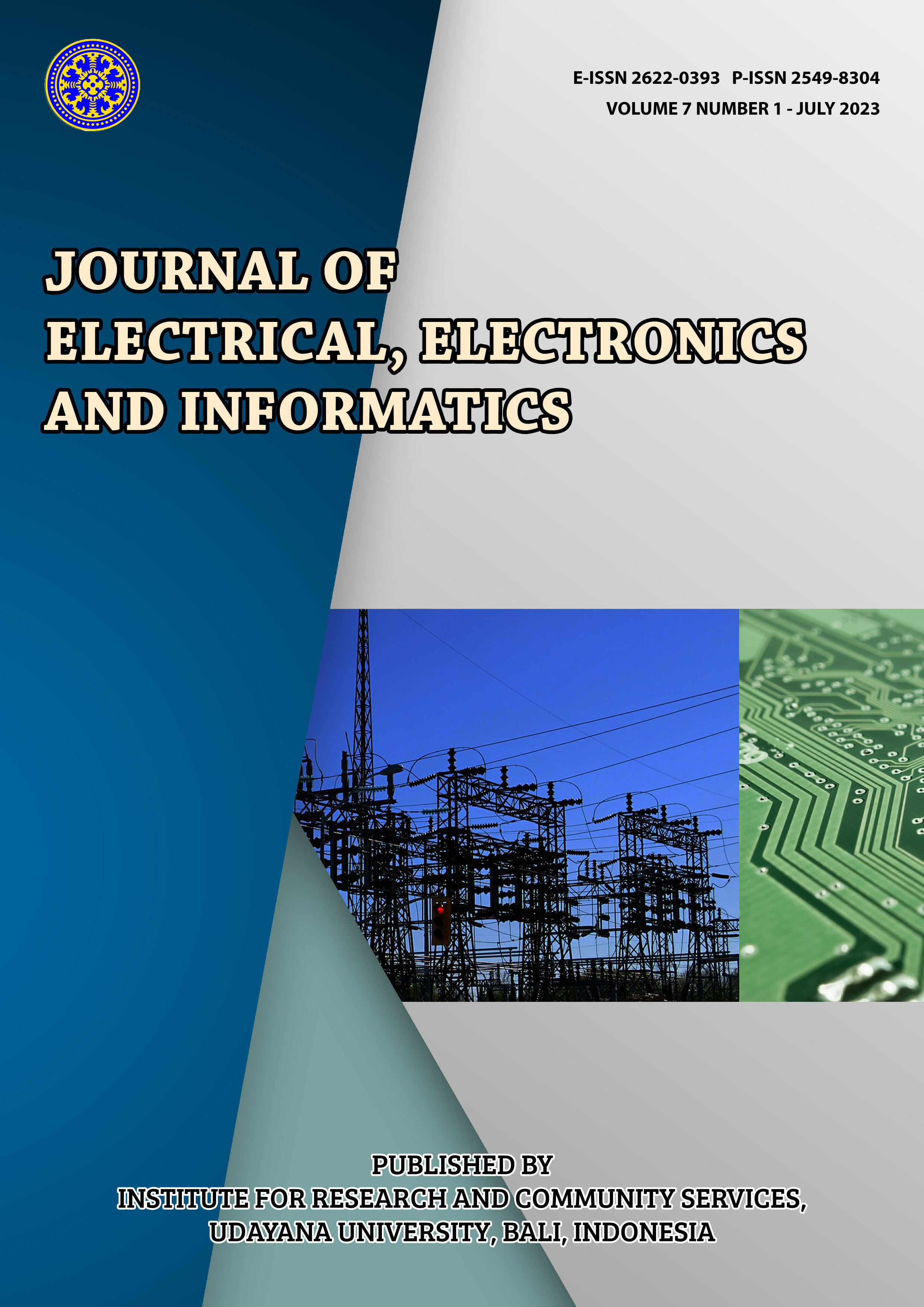Dye Sensitized Solar Cell Output Power Based on FTO Disposition Immersion Time in Papaya Leave Chlorophyll
Abstract
Dye-Sensitized Solar Cell (DSSC) is a dye-based organic solar cell as a photon absorber developed by Prof. Gratzel (1991). Natural dyes are a solution to replace synthetic dyes which are commonly used for DSSC because they are affordable, available in large quantities, environmentally friendly and sustainable. The aims of this study was to analyze the effect of immersion time on the disposition of flourine-doped tin oxide – Titanium dioxide (FTO-TiO2) in the natural dye chlorophyll on the current, voltage and power produced. Using papaya leaves extract with a direct gap energy of 2.428 Ev, FTO-TiO2 deposition was immersed in chlorophyll with 5 levels of immersion time and 3 groupings. Current and voltage measurements were made at the output of the DSSC prototype. Using the Solar Power Generation System, the output voltage (Voc) is 341.167 mV, the current (Isc) is 64.755 ?A and the output power is 1.49 x 10-5 w/cm2 at 60 hours of immersion.
Downloads
References
[2] McDonald, S.A., Konstantatos, G., Zhang, S., Cyr, P.W., Klem, E.J., Levina, L., dan Sargent, E.H. Solution-processed PbS quantum dot infrared photodetectors and photovoltaics. Nature Materials Vol. 4 (2) : 138-142. 2005.
[3] Smestad, GP, Gratzel, M. Demonstrating electron transfer and nanotechnology: Aa natural dye-sensitized nanochrystalline energy converter. Journal of Chemical Education, 75 (6), 752-756. 1998.
[4] Giusti, M. M. and R. E. Wrolstad. Characterization and measurement of anthocyanin by UV-visible spectroscopy. In R.E. Wrostald TE, Acree EA, Dekker MH. Penner DS, Reid SJ, Schwarrtz CF, Shoemaker D, Smith PS (eds). Handbook of Food Analytical Chemistry: Pigmens, Colorants, Flavors, Texture, and Bioactive Food Components, Hoboken. New Jersey. John Wiley Sons. pp 624. 2001.
[5] Maddu A, Zuhri M dan Irmansyah. Penggunaan ekstrak antosianin kol merah sebagai fotosensitizer pada Sel Surya TiO2 nanokristal tersensitisasi dye. (Use of red cabbage anthocyanin extract as a photosensitizer in dye-sensitized TiO2 nanocrystalline solar cells). Makara Teknologi Vol. 11, No. 2. 2007.
[6] Kumara, M.S.W. and Gontjang, P. Studi Awal Fabrikasi Dye Sensitized Solar Cell (DSSC) dengan Menggunakan Ekstraksi Daun Bayam (Amaranthus hybridus l) sebagai Dye Sensitizer dengan Variasi Jarak Sumber Cahaya pada DSSC. (Preliminary Study of Fabrication of Dye Sensitized Solar Cell (DSSC) Using Spinach Leaves Extract (Amaranthus hybridus l) as Dye Sensitizer with Variation of Light Source Distance on DSSC). Surabaya: Institut Teknologi Sepuluh November. hal: 111. 2012.
[7] Halme, J. Dye-sensitized nanostructured and organic photovoltaic cells: technical review and preliminary tests. Master’s theses. Department of Engineering Physics and Mathematics, Helsinki University of Technology, Espoo. 2002.
[8] Harborne, J.B. Metode fitokimia: Penuntun cara modern menganalisis tumbuhan. (Phytochemical methods: A guide to the modern way of analyzing plants). Institut Teknologi Bandung, Bandung. 1996. http://repository.ipb.ac.id/. Diakses pada Tanggal 12 April 2020.
[9] Latif,A., Monzir,S., Mahmoud, B. Dye-sensitized solar cells using dyes extracted from flowers, leaves, parks and roots of three trees. International Journal of Renewable Energy Research. Vol.5, No.1. 2015.
[10] Gobel, R.B., E. Johannes dan A.I. Latunra. Biologi Dasar. (Basic biology). Program TPB-UNHAS. Makassar. 2006.
[11] Abdilah, F., Indah, R., Ahyar, A. Pengujian Daya Antioksidan dan Sifat Toksisitas Ekstrak Co(II) Turunan Klorofil. (Antioxidant Analyses and Toxicity Properties of Chlorophyll Derivative Co(II) Extract). Jurnal MIPA. 2014.
[12] Vila, Marta M.D.C., Marco V. Chaud, and Victor M. Balcão. Microencapsulation of natural antioxidant pigments in microencapsulation and microspheres for food applications. Editor L. M. C. Sagis, Academic Press, London, 369-390. 2015.
[13] Koca, Nuray, Feryal Karadeniz, and Hande Selen Burdurlu. Effect of pH on chlorophyll degradation and colour loss in blanched green peas. Food Chemistry. United Kingdom. Volume 100, 609–615. 2007. https://doi.org/10.1016/j.foodchem.2005.09.079.
[14] Markus P. K., Widodo F. M. dan Tri W. W. Pengaruh Penambahan MgCO3 dan NaHCO3 dengan Pernbedaan Pencahayaan Terhadap Stabilitas Pigmen Klorofil a Mikroalga. (The Effect of Addition of MgCO3 and NaHCO3 with Differences in Lighting on the Stability of Microalgae Chlorophyll a Pigment). Universitas Diponegoro. Semarang. 2013.
[15] Aryanti, N., A. Nafiunisa, F. M. Willis. Ekstraksi dan karakterisasi klorofil dari daun suji (Pleomele angustifolia) sebagai pewarna pangan alami. (Extraction and characterization of chlorophyll from suji leaves (Pleomele angustifolia) as a natural food coloring). Jurnal Aplikasi Teknologi Pangan 5 (4). Indonesian Food Technologists. 2016. https://doi.org/10.17728/jatp.183.
[16] Srilakhsmi, B. Food Science, 3rd ed., New Age International, New Delhi, pp.171-211. 2003.
[17] Ludin, N.A., Al-Alwani Mahmoud, A.M., Bakar Mohamad, A., Kadhum, A.A.H., Sopian, K., Abdul Karim, N.S. Review on the development of natural dye photosensitizer for dye-sensitized solar cells. Renewable and Sustainable Energy Reviews. Volume 31, page 386–396. 2014. https://doi.org/10.1016/j.rser.2013.12.001.
[18] Setiari, Nintya and Nurchayati, Yulita. Eksplorasi kandungan klorofil pada beberapa sayuran hijau sebagai alternatif bahan dasar food supplement. (Exploration of chlorophyll content in some green vegetables as an alternative food supplement base material). Bioma Journal. Indonesia. Volume 11, no.1. pp. 6-10. 2009. https://doi.org/10.14710/bioma.11.1.6-10.
[19] Suprasetyo, A., P Setiarso. Pembuatan elektroda pasta karbon termodifikasi zeolit untuk analisis fenol secara cyclic stripping voltammetry. (Preparation of zeolite modified carbon paste electrodes for phenol analysis by cyclic stripping voltammetry). UNESA Journal of Chemistry. Vol. 5, no.3. Page 86-93. 2016.
[20] Behrang H. Hamadani and Brian Dougherty. Solar Cell Characterization. in M.P. Paranthaman et al. (ed.), Semiconductor Materials for Solar Photovoltaic Cells, Springer Series in Materials Science 218. 2016. DOI 10.1007/978-3-319- 20331-7_8.
[21] Ganta D, Jara J, Villanueva R. Dye-sensitized solar cells using aloe vera and cladode of cactus extracts as natural sensitizers. Chemical Physics Letter Journal. Netherlands. Volume 679: page 97–101. 2017. https://doi.org/10.1016/j.cplett.2017.04.094.
[22] Hikmah, Irmayatul dan Gontjang Prajitno. Pengaruh Penggunaan Gel-Electrolyte pada Prototipe Dye Sensitized Solar Cell (DSSC) berbasis TiO2 Nanopartikel dengan Ekstrak Murbei (Morus) sebagai Dye Sensitizer pada Substrat Kaca ITO. (Effect of Using Gel-Electrolyte on Dye Sensitized Solar Cell (DSSC) Prototypes based on TiO2 Nanoparticles with Mulberry Extract (Morus) as Dye Sensitizer on ITO Glass Substrates). Science and Art Journal. Institute Teknologi Sepuluh November. Surabaya – Indonesia. Volume 4, No 1. 2015. https://doi/ 10.12962/j23373520.v4i1.8655.
[23] Setiawan, I.N. Konversi sinar matahari menjadi energi listrik oleh dye sensitized solar cell (DSSC) menggunakan pewarna alami yang diekstrak dari komponen bioaktif limbah buah. (Conversion of sunlight into electrical energy by dye sensitized solar cells (DSSC) using natural dyes extracted from the bioactive components of fruit waste). Disertasi Fakultas Teknik – Universitas Udayana. Bali. 2020.
[24] Fitriya, H., Handayani, R. D., Lesmono, A. D. Pengaruh lama perendaman TiO2 dalam dye sensitizer ekstrak daun tembakau (Nicotiana tabacum L) terhadap efisiensi dye sensitizer solar cell (DSSC). (Effect of TiO2 immersion time in tobacco leaf extract dye sensitizer (Nicotiana tabacum L) on dye sensitizer solar cell (DSSC) efficiency). Jurnal Pembelajaran Fisika, Vol. 5 No. 4, hal 343 – 350. 2017.











